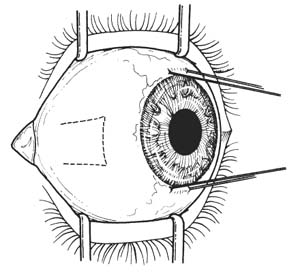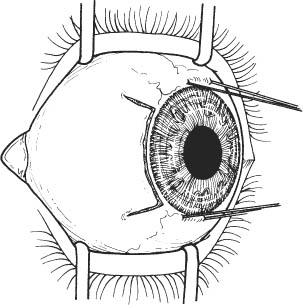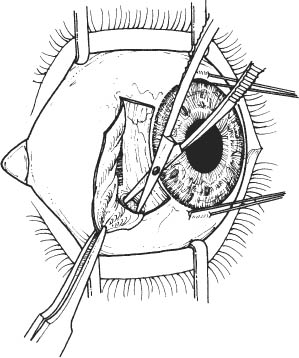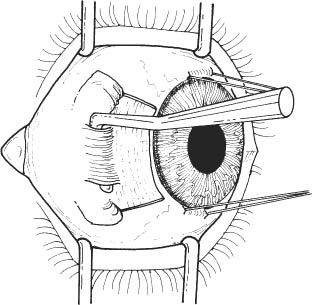40 Extraocular muscle imbalance requiring muscle weakening for correction (e.g., medial rectus in esotropia) in a patient who is cooperative for postoperative adjustment. Test the patient’s cooperativeness to postoperative adjustment. Anesthetize the eye with topical anesthetic and place an eyelid speculum in the eye. Then touch and maneuver the conjunctiva with a moistened cotton tip. A patient who does not tolerate this procedure well is a poor candidate for adjustable suture. See Chapter 3. A complete strabismus evaluation with determination of the detailed surgical plan is necessary. Note: Figures are drawn from the surgeon’s viewpoint with the surgeon standing at the head of the patient. 1. Anesthesia: General anesthesia. Retrobulbar anesthesia is possible, but you will not be able to adjust the sutures until the next day when the retrobulbar block wears off completely. 2. Place a drop of neosynephrine 2.5% into the eye to constrict the blood vessels and decrease bleeding. Prep and drape. 3. Place lid speculum. Figure 40.1 4. Place a 6–0 silk episcleral stay suture at the limbus at 6 and 12 o’clock (see Fig. 40.1). Optional: Use locking Castroviejo forceps instead of stay suture. Figure 40.2 5. Secure the globe with stay sutures to expose the surgical field. 6. Prepare a fornix-based, winged limbal peritomy down to bare sclera with Westcott scissors (see Fig. 40.2). Figure 40.3 7. Buttonhole the Tenon capsule and intermuscular septum with sharp and blunt dissection with Westcott scissors to reach bare sclera on either side of the muscle insertion (see Fig. 40.3). a. Aim 45 degrees between the horizontal and vertical recti to avoid injuring the muscles. b. Bluntly spread the incision with Westcott scissors. c. Repeat on the opposite side of the muscle insertion. Figure 40.4 8. Isolate the muscle (see Fig. 40.4). a. First sweep the Stevens tenotomy hook through the fascial buttonhole and under the muscle. Hold the hook parallel to and flush with bare sclera to facilitate passage. b. Follow with a Green muscle hook perpendicular to the sclera and just posterior to the Stevens hook. Keep the tip of the Green hook pressed against the sclera. c. Remove the Stevens tenotomy hook.
Rectus Recession with Adjustable Suture Technique
Indications
Preoperative Procedure
Instrumentation
 Lid speculum (e.g., Lancaster, Barraquer)
Lid speculum (e.g., Lancaster, Barraquer)
 Needle holder
Needle holder
 Sutures (6–0 silk with spatula needle, double-armed 6–0 Vicryl with spatula needle (S29 or S14), 7–0 Vicryl suture, 5–0 Mersilene on a spatula needle)
Sutures (6–0 silk with spatula needle, double-armed 6–0 Vicryl with spatula needle (S29 or S14), 7–0 Vicryl suture, 5–0 Mersilene on a spatula needle)
 Toothed forceps (e.g., Bishop-Harmon, 0.5 mm Castro-viejo)
Toothed forceps (e.g., Bishop-Harmon, 0.5 mm Castro-viejo)
 Two locking 0.5 mm toothed forceps
Two locking 0.5 mm toothed forceps
 Westcott scissors (rounded tips)
Westcott scissors (rounded tips)
 Cautery (bipolar forceps)
Cautery (bipolar forceps)
 Muscle hooks (e.g., Green, Jameson)
Muscle hooks (e.g., Green, Jameson)
 Stevens tenotomy hooks
Stevens tenotomy hooks
 Castroviejo caliper
Castroviejo caliper
 Tying forceps
Tying forceps
Operative Procedure
Stay updated, free articles. Join our Telegram channel

Full access? Get Clinical Tree






